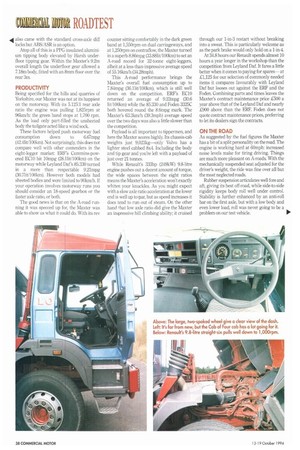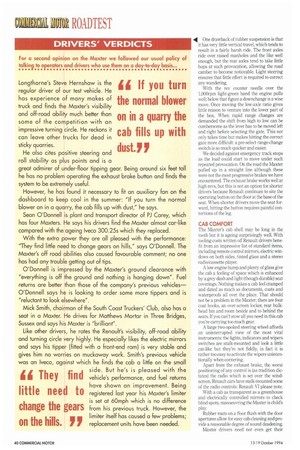TOUGH ON THE ROUGH
Page 38

Page 40

Page 42

Page 43

If you've noticed an error in this article please click here to report it so we can fix it.
As tested the 8x4 Renault Maxter was juicy on the motorway, and its Club of Four cab is hardly new. In fact the cab is has much to commend it while the driveline and handling were well suited to our test truck's demanding working environment among the quairies of Yorkshire.
When we last got our hands on a Renault Maxter 8x4 it was topped by £130,000 worth of Gallic gully emptier. So we thought it was high time we tested on one that is a little more recognisable and a lot less money. We found such a vehicle: a day-cabbed G340ti.32D 8x4 tipper running in the colours of Skipton•based haulier Ken Longthorne. It's clocked up nearly 90,000km, is fitted with a PPG insulated tipping body and arrived for test straight from Longthorne's local Renault dealer, stopping only to pick up a load.
PRODUCT PROFILE
While the Maxter was only launched a couple of years ago, it comes with the ageing Club of Four cab. But while this cab has many younger competitors it has many points in its favour,such as the abundance of glass in the back panel and behind the B-post—a detail not lost on tipper drivers who appreciate maximum visibility.
Air suspension for the rear of the cab and the driver's seat are available as optionals. Renault's 9.8-litre MDIR 0(120.45 E/3 Euro 1 engine develops 333hp (249kW) at 2,000rpm; torque is a respectable 1,144 lbft (1,550Nm) at 1,200rpm. It all feeds through a twin-plate Fichtel & Sachs clutch to Renault's double-H patterned B9 synchro box.
Our vehicle was fitted with a 5.125:1 rear axle ratio but a 4.625:1 ratio is available for hauliers in a hurry.
The Maxter has a modular chassis range with models from 4x2 through 4x4 up to the 8x4s, with three levels of chassis strengths up to 40 tonnes. UK Tipters have a level-B chassis with 6mm ditching. It is pre-drilled for bodywork and to enable the rear cross member to be bolted in a choice of two positions.
'lb iron out the bumps there are triple-leaf parabolic springs at the front while the rear axles are rubber suspended courtesy of Hendrickson Norde. Vertical repositioning of the brake chambers has increased ground clearance to 320mm at the back and 400mm up front (Renault quotes an approach angle of 28°). For good measure our vehicle was fitted with the factory option vertical exhaust. It 1106
ill also came with the standard cross-axle cliff locks but ALIS/ASR is an option.
Atop all of this is a PPG insulated aluminium tipping body elevated by Harsh underfloor tipping gear. Within the Maxter's 9.2m overall length the underfloor gear allowed a 7.18m body, fitted with an 8mm floor over the rear 3m.
PRODUCTIVITY Being specified for the hills and quarries of Yorkshire, our Maxter was not at its happiest on the motorway. With its 5.125:1 rear axle ratio the engine was pulling 1,825rpm at 96km/h: the green band stops at 1,700 rpm. As the load only part-filled the unsheeted body the tailgate acted like a wind sock.
These factors helped push motorway fuel consumption down to 6.67mpg (42.41it/100km). Not surprisingly, this does not compare well with other contenders in the eight-legger market: ERF's Cummins-powered EC10 hit lOmpg (28.11it/100km) on the motorway while Leyland Daf 's 85.330 turned in a more than respectable 9.21mpg (30.71it/100km), However both models had sheeted bodies and were limited to 90kmIh. If your operation involves motorway runs you should consider an 18-speed gearbox or the faster axle ratio, or both.
The good news is that on the A-road running it was specced up for, the Maxter was able to show us what it could do. With its rev
counter sitting comfortably in the dark green band at 1,550rpm on dual carriageways, and at 1,250rpm on contraflov.,, the Maxter turned in a superb 8.86mpg (33.881it/100km) to set an A-road record for 32-tonne eight-leggers, albeit at a less-than-impressive average speed of 55.16km/h (34.28mph).
This A-road performance brings the Maxter's overall fuel consumption up to 7.84mpg (36.11it/100km), which is still well down on the competition, ERF's EC10 returned an average of 9.23rnpg (30.6 lit/100km) while the 85.330 and Foden 3325C both hovered round the 8.6mpg mark. The Maxter's 63.3km/h (39.3mph) average speed over the two days was also a little slower than the competition.
Payload is all important to tippermen, and here the Maxter scores highly. Its chassis-cab weights just 9,023kg—only Volvo has a lighter steel cabbed 8x4. Including the body and tip gear and you're left with a payload of just over 21 tonnes.
While Renault's 333hp (249kW) 9.8-litre engine pushes out a decent amount of torque, the wide spaces between the eight ratios means the Maxter's acceleration won't exactly whiten your knuckles, As you might expect with a slow axle ratio acceleration at the lower end is well up tapar, but as speed increases it does tend to run out of steam. On the other hand that low axle ratio did give the Maxter an impressive hill climbing ability; it cruised through our 1-in-3 restart without breaking into a sweat. This is particularly welcome as as the park brake would only hold on a 1-in4.
At 34.8 hours our Renault spends almost 10 hours a year longer in the workshop than the competition from Leyland Dal. It fares a little better when it comes to paying for spares— at £1,125 for our selection of commonly needed items it compares favourably with Leyland Daf but looses out against the ERF and the Foden. Combining parts and times leaves the Maxter's contract maintenance price £500 a year above that of the Leyland Daf and nearly £900 above than the ERF. Foden does not quote contract maintenance prices, preferring to let its dealers sign the contracts.
ON THE ROAD As suggested by the fuel figures the Maxter has a bit of a split personality on the road. The engine is working hard at 60mph: increased noise levels make for tiring driving. Things are much more pleasant on A-roads. With the mechanically suspended seat adjusted for the driver's weight, the ride was fine over all but the most neglected roads.
Rubber suspension articulates well fore and aft, giving its best off-road, while side-to-side rigidity keeps body roll well under control. Stability is further enhanced by an anti-roll bar on the first axle, but with a low body and even lower load, roll was never going to be a problem on our test vehicle. One drawback of rubber suspension is that it has very little vertical travel, which tends to result in a fairly harsh ride. The front axles ride over raised manholes and the like well enough, but the rear axles tend to take little hops at such provocation, allowing the road camber to become noticeable. Light steering ensures that little effort is required to correct any wandering.
With the rev counter needle over the 1,000rpm light-green band the engine pulls well; below that figure a downchange is a wise move. Once moving the low-axle ratio gives little reason to venture into the lower part of the box. When rapid range changes are demanded the shift from high to low can be cumbersome as the lever has to be moved left and right before selecting the gate. This not only takes time but makes hitting the correct gate more difficult: a pre-select range-change switch is so much quicker and easier.
We decided against emergency track stops as the load could start to move under such repeated provocation. On the road the Maxter pulled up in a straight line although these were not the most progressive brakes we have encountered. The exhaust brake works well at high revs, but this is not an option for shorter drivers because Renault continues to site the operating button on the floor at the base of the seat. When shorter drivers move the seat forward, hitting the button requires painful contortions of the leg.
CAB COMFORT The Maxter's cab shell may be long in the tooth but it is ageing surprisingly well. With tooling costs written off Renault drivers benefit from an impressive list of standard items, including remote control mirrors, electric windows on both sides, tinted glass and a stereo radio/cassette player.
A low engine hump and plenty of glass give the cab a feeling of space which is enhanced by a grey dash and light (though durable) seat coverings. Nothing makes a cab feel cramped and dated as much as documents, coats and waterproofs all over the place. That should not be a problem in the Maxter; there are four coat hooks, an over-screen locker, rear bulkhead bin and room beside and to behind the seats. If you can't stow all you need in this cab you're carrying too much gear.
A large two-spoked steering wheel affords an uninterrupted view of the most vital instruments: the lights, indicators and wipers switches are stalk-mounted and look a little car-like but they're not fiddly, in fact it is rather too easy to activate the wipers unintentionally when cornering.
Apart from the exhaust brake, the worst positioning of any control is (as tradition dictates) the radio which is set over the windscreen. Renault cars have stalk-mounted some of the radio controls: Renault VI please note.
With a cab as transparent as a greenhouse and electrically controlled mirrors to check blind spots, manoeuvring the Maxter is child's play.
Rubber mats on a floor flush with the door apertures allow for easy cab cleaning and provide a reasonable degree of sound deadening.
Maxter drivers need not even get their
hands dirty checking the engine oil; with the ignition on and the engine off, the oil pressure gauge indicates the oil level.
SUMMARY
From the outside looking in it would be too easy to dismiss the Maxter as a thirsty truck with an outdated cab. Easy, but unfair. The vehicle we drove was not set up for motorway running, but you can readily select axle and gearbox options to suit a Maxter for such work. On quarry and A-road work, for which our vehicle was specified, the Maxter's performance speaks for itself.
From the inside looking out the Maxter is a competent, workmanlike truck with a decent payload at a reasonable price, and with a lot of extras thrown in. Its combination of ground clearance, visibility and agility makes it well suited to off-road work. Tipper operators will find the Maxter equal to the task, but they should choose the spec carefully.
E by Colin Sowman
























































































































